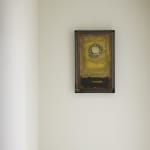Kazuki Yasuo (1911−1974)
The Sun
Oil on canvas, framed (8M)
Signed and titled by the artist on the back
45 x 27 cm
51 x 33 cm (overall)
Further images
The mixed media of calcite and charcoal powder of this work generates a unique texture, which resembles to that of rocks. Kazuki Yasuo applies a palette of somber yellow ocher and dark black. The blank spaces left unpainted on the surface enhance the viewers’ imagination. The elongated shape of the work is said to have been chosen by the artist so as to fit in the tokonoma alcove in a Japanese interior. Kazuki sought for the “oil painting for the Japanese,” which transcends the border between the East and the West, not only through his selection of the painting media, but also through the consideration of the space where the work is to be viewed. The present work is an example of such.
I came to appreciate the moon and the sun after I joined the army to Manchuria and was
interned to Siberia. When I thought about my family at home who are viewing the same
sun and moon as me, I could not help but feeling grateful and nostalgic towards them.
(Kazuki Yasuo gashu: Seimei no sanka)
As his most known work Black Sun demonstrates, the sun is a recurring subject for Kazuki. The four years in Manchuria and Siberia was a traumatic experience for Kazuki, and the sun that caused him strong homesick in the end became a powerful motif for him.
Kazuki Yasuo (yoga painter; 1911–1974)
Yamaguchi-born yoga painter. Graduated from Tokyo School of Fine Arts. Studied under Fujishima Takeji. The unique texture resulted from the mixed media of calcite and charcoal powder becomes his unusual style. Widely known for the “Siberia series” based on his Siberia internment experience. Awarded the New Bunten exhibition special prize, Kokuga-kai special prize, Nishinihon bunka-sho (West Japan cultural prize), and Shinchosha nihon geijutsu taisho (Shinchosha Japan fine arts prize). Received the Third Order of the Sacred Treasure.
I came to appreciate the moon and the sun after I joined the army to Manchuria and was
interned to Siberia. When I thought about my family at home who are viewing the same
sun and moon as me, I could not help but feeling grateful and nostalgic towards them.
(Kazuki Yasuo gashu: Seimei no sanka)
As his most known work Black Sun demonstrates, the sun is a recurring subject for Kazuki. The four years in Manchuria and Siberia was a traumatic experience for Kazuki, and the sun that caused him strong homesick in the end became a powerful motif for him.
Kazuki Yasuo (yoga painter; 1911–1974)
Yamaguchi-born yoga painter. Graduated from Tokyo School of Fine Arts. Studied under Fujishima Takeji. The unique texture resulted from the mixed media of calcite and charcoal powder becomes his unusual style. Widely known for the “Siberia series” based on his Siberia internment experience. Awarded the New Bunten exhibition special prize, Kokuga-kai special prize, Nishinihon bunka-sho (West Japan cultural prize), and Shinchosha nihon geijutsu taisho (Shinchosha Japan fine arts prize). Received the Third Order of the Sacred Treasure.





